Nowadays, when people hear the words “email blast” they think “spam” (or worse yet, malware invasion). And yet, email is the sales/marketing method of choice when soliciting new prospects and nurturing ones in the pipeline. As we are inundated with more and more email messages each day, the question that naturally gets asked is “Does email marketing work?”
HubSpot recently published an article indicating that more businesses are using email marketing on a larger scale than ever before. They claim that when email is used as a marketing method for lead nurturing, there is a reported 20% increase in sales opportunities generated. It would seem that the pundits who criticized email blasts when they first started becoming popular were wrong. In fact, “junk mail didn’t kill email the way most ‘experts’ expected. Instead, the struggle to stay afloat in an ocean of junk made permission emailers much, much stronger.”
Here are some other statistics that are interesting to keep in mind:
- Worldwide daily email traffic (sent and received): 269 billion emails
- By the end of 2021, the number of worldwide email users will be over 4.1 billion
- Average number of emails an office worker receives per day: 121
- Average email click-through rates on mobile devices: 12.7% (on PCs, that number is only floating around 13%)
- Top reason why prospects unsubscribe: “I get too many emails in general.”
Seventy percent of individuals polled in a study conducted by global research firm McKinsey & Company readily admit that they will always open an email, if it is from one of their favorite businesses. And Salesforce claims that 95 percent of individuals who opt-in to email subscription lists find the emails to be “somewhat or very useful.”
So, how can you make your next email blast a success? Here are some tips:
Attention please!
Attention-grabbing subject lines are a must. They must intrigue the recipient enough to get them to open the message, but not too cheeky that they’ll think it’s a sales ploy (or a virus). Be wary of using wording that sounds too “pushy” or using anything with the word free (which will certainly get filtered into the spam folder).
If you have an event, don’t use a subject line that says “You’re invited”, but one that says “What you’ll be doing 2 weeks from Tuesday.” Some marketers recommend boring subject lines — MailChimp says not to “sell what’s inside, just tell what’s inside”, but I think that humor works best. Either way, you need to first get past spam filters, then catch the reader’s attention (in a good way) so experimenting with different subject lines and benchmarking them against one another is a good idea.
Of course, it’s important to keep the subject line relevant to the content within the body of the email — otherwise your readers may be confused or feel tricked.
Targeted messaging
Keep emails short and to the point. Explain to your audience why what you have to say is important and moreover, how it will benefit them. Readers are more likely to click on a link and engage in an action if you provide basic information in your email (instead of rambling on for pages and pages) and embed (several) links within the text.
Our experience is that creating more than one email message (one per job title or industry sector, for example) provides a better return. One-sized-fits all content doesn’t work, so it’s more effective to tweak your key messages for each specific niche you’re addressing. In addition, local language coverage (especially in EMEA) is a great way to show your prospects that you care about them; this will help ensure your messages won’t get lost in translation.
Clean your data and obtain email opt-ins
A high bounce rate when you’re sending out emails means that your list of prospects is out of date. Running regular data cleansing activities helps keep out what’s irrelevant, so that you can focus on what is. Make sure to do this regularly (at least once a quarter) so that your lists stay current.
As mentioned earlier, prospects that opt-in to receive information are more likely to read it — when people show an interest in the topic prior to receiving an email, they have higher engagement rates. What that means is running pre-emailing data builds to (verbally) obtain opt-ins and confirm that those prospects are the best people to discuss the topic with is a must. In addition, new GDPR rules and regulations in Europe require it, so there’s no way around this nowadays.
Send emails at the right time
It used to be that the best time to send out emails (if you wanted them to be read) was on Thursdays at 11 am. (Don’t ask me why or how I know that, it was just a standard industry norm.) Now, that’s no longer the case in large part because people are reading emails on the go, in public transportation, on the beach, and more and more on their mobile devises. We have found that programming messages to be sent on Saturday mornings (between 10 and 11 am local time in the country of receipt) gives the best reactivity rate (openers and click-through rates). I think this is partly due to the fact that we’re all more connected than ever before and also because we naturally receive less business-related emails on the weekend (so we’re more likely to notice them).
Think mobile-friendly
In 2016, consulting emails on mobile devices surpassed desktop usage for reading email. Now more than 55% of all emails are being opened on mobile devices. Surprisingly, however, many email messages are not designed for optimized viewing on mobiles, which means they are likely to go unread. Mobile optimization is mandatory in today’s (marketing) world so it’s not a tactic to overlook.
Conclusion
Email marketing can work if it’s done right. If you target the right people with the right message, in the right format and at the right time, (that’s a lot of rights!) it can have a significant impact on sales in the mid-run. Randomly casting out the biggest net you can find in the hopes that you’ll catch a small fish, however, is a waste of time (and will only hurt your image by turning you into a massive spammer). Creating a series of email messages that are sent to the same people over an established period of time with a set workflow and messaging that changes depending on how they react (drip email campaigns) is a good way to establish consistency. More on this to come!










